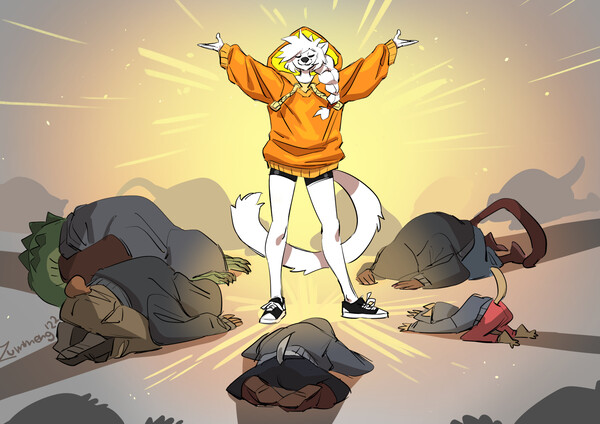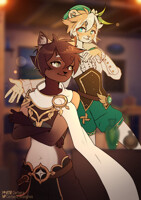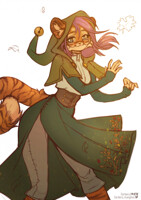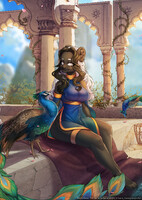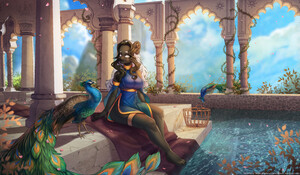Views: 72
Submissions: 0
Favs: 0
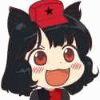
Registered: Jan 14, 2025 08:46
Also known as Libertad. Avid nerd, tabletop specialist, writer of countless RPG sourcebook reviews.
Avatar is Catalunya from the Political Ideology Catgirls webcomic. Play on words of Catalonia, a region of Spain that was home to anarchist anti-Franco forces. I forgot where I originally got the image.
Avatar is Catalunya from the Political Ideology Catgirls webcomic. Play on words of Catalonia, a region of Spain that was home to anarchist anti-Franco forces. I forgot where I originally got the image.
Gallery
This user has no submissions.
Recent Watchers
Stats
Comments Earned: 0
Comments Made: 0
Journals: 7
Comments Made: 0
Journals: 7
Recent Journal
Furry-Friendly D&D Settings #7: Beast World
2 months ago
While the worlds covered so far in these journal entries have certain anthropomorphic people with prominent roles in history and society, we haven’t had one where said groups were front and center. Enter the Beast World, a relatively new setting created by members of the furry fandom.
In terms of Lore, the Beast World was originally a wild land home to animals and a sleeping pantheon of Seelie. It was later discovered by a pantheon of six gods, one of whom uplifted the native animals into sapient people heretofore known as “beasts.” The one responsible was the goddess Pirhoua, who is the most popular deity and takes on the role of a creator mother in the world’s religious traditions.
The anthropomorphic people are colloquially called “beasts” in reference to their animalistic origins. Mundane animals still exist, and the primary dividing line for what qualifies as a sapient entity is “willfulness.” A willful creature has an enhanced sense of self-awareness: a distinct identity that separates itself from others and is capable of personal growth and change. Non-willful creatures are referred to as quiet-minded.
While willful creatures are capable of siring children with each other, children of mixed species inherit the traits of only one parent. There are no “hybrids.” Additionally, while various species have their own historical homelands and can be found in great numbers there, civilizations generally aren’t homogenous and each of the five major regions count people of many lineages.
All of the willful species native to the Beast World are mammals and include bovine (cattle), canine (dogs and wolves), celerine (rabbits and squirrels), cervine (deer), equine (horses and donkeys), felines (shorthair/house cats and big cats), laetine (otters and ferrets), ligonine (armadillos, moles, and sloths), murine (rats and mice), ovine (sheep), tenebrine (possums and raccoons), ursine (bears), vulpine (fennec and red foxes). There are also extraplanar immigrants and visitors, such as such as brethren who are humans that escaped the cosmic destruction of their Broken World; kobolds and dragons, who came from the Ancestral Homeland which is ruled over and terraformed by various elder dragons; fey-like jackals, who mostly live in the Dreaming which is collectively formed from the sleeping thoughts of the Beast World’s inhabitants; and bats, who live the Astral Sea and inhabit post-scarcity cities whose foundations are shaped from the plane’s very essence.
In regards to Playability, the 18 major species mentioned above are all playable. 16 of them were balanced in line with each other, but jackals and dragons are specifically called out as having relatively more powerful features on account of reflecting the fact that they are an ancient and mighty people in the lore. Virtually every species of the Beast World gets five unique Homeland Traits for their ancestry, which grant specific features and/or proficiencies based on the region in which they grew up. The extraplanar groups either don’t have Homeland Traits (kobolds, dragons, jackals) and get some other equivalent subfeature, or are recent arrivals and thus treat the plane of existence as their sole Homeland (bats, brethren).
The Delver’s Guide also has a sidebar for guidelines in making your own species, for those who wish to include anthropomorphic animals that aren’t covered in the above.
In terms of Lore, the Beast World was originally a wild land home to animals and a sleeping pantheon of Seelie. It was later discovered by a pantheon of six gods, one of whom uplifted the native animals into sapient people heretofore known as “beasts.” The one responsible was the goddess Pirhoua, who is the most popular deity and takes on the role of a creator mother in the world’s religious traditions.
The anthropomorphic people are colloquially called “beasts” in reference to their animalistic origins. Mundane animals still exist, and the primary dividing line for what qualifies as a sapient entity is “willfulness.” A willful creature has an enhanced sense of self-awareness: a distinct identity that separates itself from others and is capable of personal growth and change. Non-willful creatures are referred to as quiet-minded.
While willful creatures are capable of siring children with each other, children of mixed species inherit the traits of only one parent. There are no “hybrids.” Additionally, while various species have their own historical homelands and can be found in great numbers there, civilizations generally aren’t homogenous and each of the five major regions count people of many lineages.
All of the willful species native to the Beast World are mammals and include bovine (cattle), canine (dogs and wolves), celerine (rabbits and squirrels), cervine (deer), equine (horses and donkeys), felines (shorthair/house cats and big cats), laetine (otters and ferrets), ligonine (armadillos, moles, and sloths), murine (rats and mice), ovine (sheep), tenebrine (possums and raccoons), ursine (bears), vulpine (fennec and red foxes). There are also extraplanar immigrants and visitors, such as such as brethren who are humans that escaped the cosmic destruction of their Broken World; kobolds and dragons, who came from the Ancestral Homeland which is ruled over and terraformed by various elder dragons; fey-like jackals, who mostly live in the Dreaming which is collectively formed from the sleeping thoughts of the Beast World’s inhabitants; and bats, who live the Astral Sea and inhabit post-scarcity cities whose foundations are shaped from the plane’s very essence.
In regards to Playability, the 18 major species mentioned above are all playable. 16 of them were balanced in line with each other, but jackals and dragons are specifically called out as having relatively more powerful features on account of reflecting the fact that they are an ancient and mighty people in the lore. Virtually every species of the Beast World gets five unique Homeland Traits for their ancestry, which grant specific features and/or proficiencies based on the region in which they grew up. The extraplanar groups either don’t have Homeland Traits (kobolds, dragons, jackals) and get some other equivalent subfeature, or are recent arrivals and thus treat the plane of existence as their sole Homeland (bats, brethren).
The Delver’s Guide also has a sidebar for guidelines in making your own species, for those who wish to include anthropomorphic animals that aren’t covered in the above.
User Profile
Accepting Trades
No Accepting Commissions
No Favorite Games
Dungeons & Dragons

 FA+
FA+
